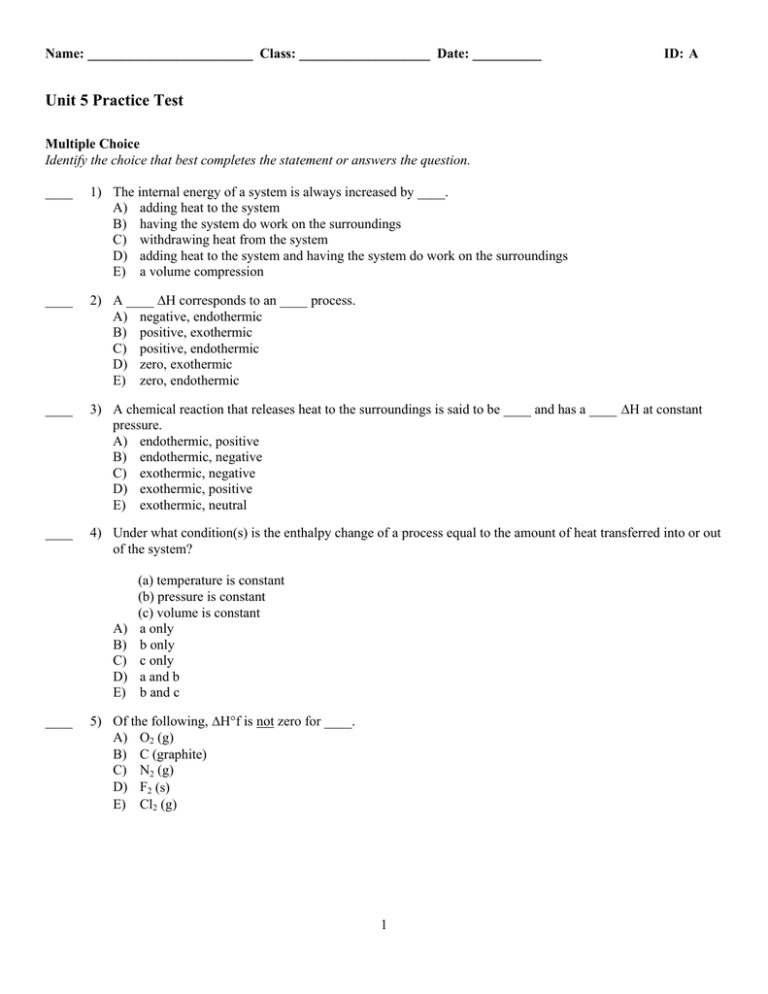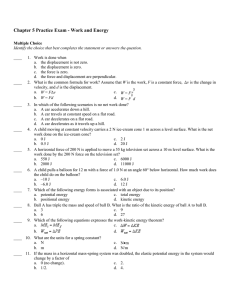ExamView - Unit 5 Practice.tst
Anuncio

Name: ________________________ Class: ___________________ Date: __________ ID: A Unit 5 Practice Test Multiple Choice Identify the choice that best completes the statement or answers the question. ____ 1) The internal energy of a system is always increased by ____. A) adding heat to the system B) having the system do work on the surroundings C) withdrawing heat from the system D) adding heat to the system and having the system do work on the surroundings E) a volume compression ____ 2) A ____ H corresponds to an ____ process. A) negative, endothermic B) positive, exothermic C) positive, endothermic D) zero, exothermic E) zero, endothermic ____ 3) A chemical reaction that releases heat to the surroundings is said to be ____ and has a ____ H at constant pressure. A) endothermic, positive B) endothermic, negative C) exothermic, negative D) exothermic, positive E) exothermic, neutral ____ 4) Under what condition(s) is the enthalpy change of a process equal to the amount of heat transferred into or out of the system? A) B) C) D) E) ____ (a) temperature is constant (b) pressure is constant (c) volume is constant a only b only c only a and b b and c 5) Of the following, H°f is not zero for ____. A) O2 (g) B) C (graphite) C) N2 (g) D) F2 (s) E) Cl2 (g) 1 Name: ________________________ ID: A ____ 6) For the species in the reaction below, H°f is zero for ____. 2Co (s) + H2 (g) + 8PF3 (g) 2HCo(PF3)4 (l) A) Co (s) B) H2 (g) C) PF3 (g) D) HCo(PF3)4 (l) E) both Co(s) and H2 (g) ____ 7) With reference to enthalpy changes, the term standard conditions means ____. (a) P = 1 atm (b) some common temperature, usually 298 K (c) V = 1 L A) a only B) b only C) c only D) a and c E) a and b ____ 8) Calculate the kinetic energy in J of an electron moving at 6.00 106 m/s. The mass of an electron is 9.11 10–28 g. A) 4.98 10–48 J B) 3.28 10–14 J C) 1.64 10–17 J D) 2.49 10–48 J E) 6.56 10–14 J ____ 9) Calculate the kinetic energy in joules of an 80.0 g bullet traveling at 300.0 m/s. A) 3.60 106 J B) 1.20 104 J C) 3.60 103 J D) 12.0 J E) 80.0 J ____ 10) The value of H° for the reaction below is –72 kJ. ____ kJ of heat are released when 80.9 grams of HBr is formed in this reaction. A) B) C) D) E) H2 (g) + Br2 (g) 2HBr (g) 144 72 0.44 36 –72 2 Name: ________________________ ID: A ____ 11) The value of H° for the reaction below is –482 kJ. Calculate the heat (kJ) released to the surroundings when 38.5 g of O2 (g) reacts with excess CO. A) B) C) D) E) 2CO (g) + O2 (g) 2CO2 (g) 2.65 103 kJ 482 kJ 580. kJ 65.7 kJ 210. kJ ____ 12) The value of H° for the reaction below is –1107 kJ: 2Ba (s) + O2 (g) 2BaO (s) How many kJ of heat are released when 15.75 g of Ba (s) reacts completely with oxygen to form BaO (s)? A) 20.8 kJ B) 63.5 kJ C) 114 kJ D) 70.3 kJ E) 35.1 kJ ____ 13) Given the following reactions N2 (g) + O2 (g) 2NO (g) H = +180.7 kJ 2NO (g) + O2 (g) 2NO2 (g) H = –113.1 kJ the enthalpy of reaction for 4NO (g) 2NO2 (g) + N2 (g) is ____ kJ. A) 67.6 B) 45.5 C) –293.8 D) –45.5 E) 293.8 3 Name: ________________________ ID: A ____ 14) Given the data in the table below, H°rxn for the reaction C2H5OH (l) + O2 (g) CH3CO2H (l) + H2O (l) is ____ kJ. A) B) C) D) E) –79.0 –1048.0 –476.4 –492.6 The value of H°f of O2 (g) is required for the calculation. ____ 15) Given the data in the table below, H°rxn for the reaction SO3 (g) + H2O (l) H2SO4 (l) is ____ kJ. A) B) C) D) E) –132 1496 704 –704 –2.16 103 ____ 16) The kinetic energy of a 26.9-g object moving at a speed of 81.9 m/s is ________ J. A) 145 B) 0.950 C) 90.2 D) 90200 E) 1450 4 Name: ________________________ ID: A ____ 17) At what velocity (m/s) must a 19.9 g object be moving in order to possess a kinetic energy of 1.0 J? A) 0.35 m/s B) 2.8 m/s C) 0.13 m/s D) 0.031 m/s E) 0.016 m/s ____ 18) The value of ΔE for a system that performs 151 kJ of work on its surroundings and loses 79 kJ of heat is ________ kJ. A) +230. B) –230. C) +72 D) –72 E) –151 ____ 19) The temperature of a 11.8 g sample of calcium carbonate [CaCO3 (s)] increases from 24.8 °C to 38.0 °C. If the specific heat of calcium carbonate is 0.82 J/g-K, how many joules of heat are absorbed? A) 130 J B) 0.92 J C) –130 J D) –0.92 J E) 11 J ____ 20) A 22.9 g sample of iron absorbs 155 J of heat, upon which the temperature of the sample increases from 23.9 °C to 38.9 °C. What is the specific heat of iron? A) 0.451 J/g-K B) –0.451 J/g-K C) 237 J/g-K D) 102 J/g-K E) 53,200 J/g-K ____ 21) The H for the solution process when solid sodium hydroxide dissolves in water is 44.4 kJ/mol. When a 12.6-g sample of NaOH dissolves in 250.0 g of water in a coffee-cup calorimeter, the temperature increases from 23.0 °C to ________°C. Assume that the solution has the same specific heat as liquid water, i.e., 4.18 J/g-K. A) 35.2 B) 24.0 C) 36.4 D) 35.7 E) 40.2 Short Answer 1) ________ is defined as the energy used to move an object against a force. 5 Name: ________________________ ID: A 2) Given the equation H2O (l) H2O (g) Hrxn = 40.7 kJ at 100 °C Calculate the mass of liquid water (in grams) at 100 °C that can converted to vapor by absorbing 2400 J of heat. 3) Given the equation H2O (l) H2O (g) Hrxn = 40.7 kJ at 100 °C Calculate the heat required to convert 3.00 grams of liquid water at 100 °C to vapor. 4) When 0.800 grams of NaOH is dissolved in 100.0 grams of water, the temperature of the solution increases from 25.00 °C to 27.06 °C. The amount of heat absorbed by the water is ________ J. (The specific heat of water is 4.18 J/g-°C.) 5) Given the equation: CH4 (g) + 2 O2 (g) CO2 (g) + H2O (l) H = –890.0 kJ The heat liberated when 34.78 grams of methane (CH4) are burned in an excess amount of oxygen is ________ kJ. 6) The standard enthalpy change of a reaction is the enthalpy change when all reactants and products are at ________ pressure and a specific temperature. 7) Coal contains hydrocarbons of high molecular weight as well as compounds containing ________, oxygen, or nitrogen. True/False Indicate whether the statement is true or false. ____ 1) Work equals force times distance. ____ 2) One joule equals 1 kg-m2/s2. ____ 3) Units of energy include newtons, joules, and calories. ____ 4) The primary component of natural gas is propane. ____ 5) Renewable energy sources are essentially inexhaustible. ____ 6) Petroleum is a liquid composed of hundreds of compounds. 6 ID: A Unit 5 Practice Test Answer Section MULTIPLE CHOICE 1) ANS: OBJ: 2) ANS: OBJ: 3) ANS: OBJ: 4) ANS: OBJ: 5) ANS: OBJ: 6) ANS: OBJ: 7) ANS: OBJ: 8) ANS: OBJ: 9) ANS: OBJ: 10) ANS: OBJ: 11) ANS: OBJ: 12) ANS: OBJ: 13) ANS: OBJ: 14) ANS: OBJ: 15) ANS: OBJ: 16) ANS: OBJ: 17) ANS: OBJ: 18) ANS: OBJ: 19) ANS: OBJ: 20) ANS: OBJ: A 5.2; G2 C 5.2, 5.3; G2 C 5.2, 5.3; G4 B 5.2, 5.3; G2 D 5.7; G2 E 5.7; G4 E 5.7; G2 C 5.1; G4 C 5.1; G4 D 5.4; G4 C 5.4; G4 B 5.4; G4 C 5.6; G4 D 5.7; G4 A 5.7; G4 C 5.1; G4 A 5.1; G4 B 5.2; G4 A 5.5; G4 A 5.5; G4 PTS: 1 DIF: 2 REF: Page Ref: 5.2 PTS: 1 DIF: 1 REF: Page Ref: 5.3 PTS: 1 DIF: 2 REF: Page Ref: 5.4 PTS: 1 DIF: 3 REF: Page Ref: 5.4 PTS: 1 DIF: 2 REF: Page Ref: 5.7 PTS: 1 DIF: 1 REF: Page Ref: 5.7 PTS: 1 DIF: 1 REF: Page Ref: 5.7 PTS: 1 DIF: 2 REF: Page Ref: 5.1 PTS: 1 DIF: 2 REF: Page Ref: 5.1 PTS: 1 DIF: 2 REF: Page Ref: 5.4 PTS: 1 DIF: 3 REF: Page Ref: 5.4 PTS: 1 DIF: 3 REF: Page Ref: 5.4 PTS: 1 DIF: 3 REF: Page Ref: 5.6 PTS: 1 DIF: 3 REF: Page Ref: 5.7 PTS: 1 DIF: 3 REF: Page Ref: 5.7 PTS: 1 DIF: 2 REF: Page Ref: 5.1 PTS: 1 DIF: 2 REF: Page Ref: 5.1 PTS: 1 DIF: 2 REF: Page Ref: 5.2 PTS: 1 DIF: 3 REF: Page Ref: 5.5 PTS: 1 DIF: 3 REF: Page Ref: 5.5 1 ID: A 21) ANS: D OBJ: 5.5; G4 PTS: 1 DIF: 4 REF: Page Ref: 5.5 PTS: 1 OBJ: 5.1; G4 2) ANS: 1.061 grams DIF: 2 REF: Page Ref: 5.1 PTS: 1 OBJ: 5.5; G4 3) ANS: 6.78 kJ DIF: 3 REF: Page Ref: 5.5 PTS: 1 OBJ: 5.5; G4 4) ANS: 868 DIF: 3 REF: Page Ref: 5.5 PTS: 1 OBJ: 5.5; G4 5) ANS: 1929 kJ DIF: 3 REF: Page Ref: 5.5 PTS: 1 OBJ: 5.5; G4 6) ANS: 1 atm DIF: 3 REF: Page Ref: 5.5 PTS: 1 OBJ: 5.7; G2 7) ANS: sulfur DIF: 2 REF: Page Ref: 5.7 PTS: 1 OBJ: G7 DIF: 2 REF: Page Ref: 5.8 PTS: 1 DIF: 1 REF: Page Ref: 5.1 PTS: 1 DIF: 2 REF: Page Ref: 5.1 SHORT ANSWER 1) ANS: Work TRUE/FALSE 1) ANS: OBJ: 2) ANS: OBJ: T 5.1; G2 T 5.1; G2 2 ID: A 3) ANS: OBJ: 4) ANS: OBJ: 5) ANS: OBJ: 6) ANS: OBJ: F 5.1; G2 F G2 T G2 T G2 PTS: 1 DIF: 1 REF: Page Ref: 5.1 PTS: 1 DIF: 1 REF: Page Ref: 5.8 PTS: 1 DIF: 1 REF: Page Ref: 5.8 PTS: 1 DIF: 2 REF: Page Ref: 5.8 3 Unit 5 Practice Test [Answer Strip] E _____ 6) C 11) _____ ID: A D 14) _____ A _____ 1) A 17) _____ B 18) _____ E _____ 7) B 12) _____ C _____ 2) A 19) _____ C _____ 8) A 15) _____ C _____ 3) C 13) _____ A 20) _____ C _____ 9) B _____ 4) D 21) _____ D 10) _____ C 16) _____ D _____ 5) Unit 5 Practice Test [Answer Strip] T _____ 1) T _____ 2) F _____ 3) F _____ 4) T _____ 5) T _____ 6) ID: A
